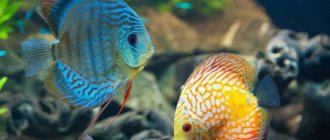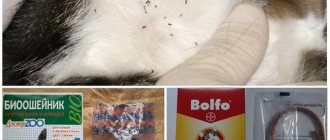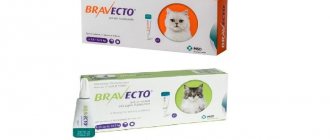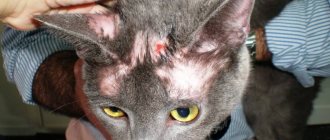Cat fleas are the most common species of all members of the flea family. Insects are distinguished by their vitality and adaptability. They parasitize not only cats, but also dogs, birds, and are aggressive towards people. This type of pest is one of the most powerful - when migrating to rodents, they completely replace rat fleas. If you know what a cat flea looks like, the characteristics of its reproduction and parasitism, the fight against a dangerous pest will be greatly simplified.
How to recognize cat fleas
Cat fleas look the same as their close relatives: dog fleas and rat fleas. Only a highly specialized entomologist can distinguish one species from another. The parasite is characterized by its small size and dark brown shiny color. The body length of the imago ranges from 2-5 mm. The fertilized female, whose eggs are formed, increases in size to 15 mm.
The cat flea in the photo has a very menacing appearance due to its sloping forehead, close-set eyes and abundance of bristles densely covering the body. These peculiar teeth allow the parasite to move freely in the fur of a cat or other animal.
Fleas
The insect does not have wings; their presence would prevent them from moving in the thick cover of the prey. The lack of flying abilities is more than compensated for by its jumping ability, which is provided by 3 pairs of legs. The hind legs are especially strongly developed; a special protein, resilin, accumulates in the muscle part, thanks to which the flea is able to cover a distance 200 times greater than its own size in one jump.
Interesting!
Fleas are famous for their jumping, but during landing they are absolutely helpless and cannot accurately project the landing site. Insects do not suffer damage solely due to their light weight.
The cat flea differs from the dog flea in its flattened forehead, and from the rat flea in its more even body structure and smaller size. These differences can only be identified in photographs of cat fleas or through detailed examination under a microscope.
What does a cat flea look like: a look under a microscope
Cat fleas look like very small dark-colored insects that literally appear for a moment among the animal's hair and immediately hide in the fur. The cat flea is more noticeable on a person, if only because it cannot hide in the hair, and prefers to bite precisely on the hairless parts of the body - legs, buttocks, back and stomach. Here it looks like a tiny shiny insect that is very difficult to catch - fleas are excellent at jumping at distances of up to 30 cm.
The photo below shows a cat flea on a human body:
On a note
From the place from which the flea begins to jump, it disappears almost instantly - the human eye is not able to follow the movement of the insect at such speed. This is how fleas create a kind of optical illusion: it seems as if the insect has simply disappeared.
Cat fleas are very small insects. Their body length, depending on age, ranges from 0.8 to 4 mm, more often 2-3 mm. The color is dark brown with a clearly visible shine.
Next in the photo is a cat flea under a microscope:
And in the next photo there are cat fleas in the animal’s fur:
Cat fleas do not have wings, but they have very powerful pushing hind legs, which provide them with the ability to jump long distances. The body of insects is compressed laterally and elongated in height. This is an adaptive mechanism:
- thanks to it, the flea can quickly and deftly move among the hairs in the host’s fur
- a flat, strong body is more difficult to crush by mechanical compression
- a flat body experiences less air resistance during a jump.
This is interesting
Dense body coverings and a flattened shape very effectively protect cat fleas from being crushed: for example, even after catching an insect, it is impossible to crush it with your fingertips, and a fingernail should be used to destroy it. Partly due to this invulnerability, parasites do not mask their bites with anesthetic enzymes: the flea bites are very painful.
The cat flea differs from related species - rat and dog - by being slightly smaller in size. In addition, in a rat flea, the back of the body is slightly raised up, while in a dog flea, the head is large. But such details are very difficult to discern with the naked eye (see photo):
It is also useful to read: Why fleas are dangerous for humans
Features of parasitism and reproduction
The mouthparts of cat fleas are designed in such a way that they can only feed on blood. Due to the short proboscis, the parasite is in an almost vertical position during a meal and part of its body is in the wound. All adults feed on blood, regardless of gender.
Fleas on cats
Fleas select prey based on temperature fluctuations and the smell of the prey. Having jumped onto a cat or other animal, the parasite makes several punctures. Having had enough of its fill, it leaves the donor’s body and begins to actively mate. Embryos form in the female's body. The female does not have the qualities of a hen and squeezes the eggs out of herself while moving. During her life, the female reproduces from 300 to 500 embryos.
On a note!
Cat flea eggs have a smooth shell and miniature size of 0.5 mm. Most of them are concentrated in the cat's bedding; occasionally they can be found in the pet's fur. The absence of an adhesive substance on the shell and the peculiarity of the reproductive function of the female ensure the spread of eggs throughout the room or nearby space to places where fleas accumulate.
Under favorable conditions, the eggs develop within 5-10 days, after which fleshy, worm-like larvae emerge from them. Newborn individuals feed on organic remains and waste products of the imago. They are usually not found in cat fur. The younger generation hides in secluded dark corners of the apartment. If there is a food supply and favorable temperature conditions, after 9 days the larvae enter the pupation stage.
Lifespan of a parasite
How long cat fleas live depends on environmental conditions and the ability to eat well. Optimal conditions for life:
- humidity 60%;
- temperature 24-28°C.
At these temperature and humidity levels, a cat flea lives for 1.5 years (including the stages of egg, larvae, and pupa), provided that it dies a natural death. However, in the natural environment, the average life expectancy does not exceed 3 months. As temperatures rise, developmental stages occur faster and the life cycle is greatly reduced.
Stages of flea development
A decrease in temperature slows down the development of the insect at all stages, and at temperatures below 3°C the parasites die.
Interesting!
Cat fleas can live for 2 months without food. During a starvation diet, they do not fall into suspended animation and continue to actively move. Lack of nutrition only affects the reproduction of the population. Eggs do not form in the body of a hungry female.
Why are cat fleas dangerous?
The parasites do not disguise themselves during the bite and do not inject anesthetic substances into the puncture site. Flea saliva contains an enzyme that has a protein structure and provokes allergic reactions. Symptoms of a flea bite:
- pain;
- severe itching;
- the appearance of red blisters and swelling.
Regular attacks by bloodsuckers can lead to weakening, decreased immunity, and anemia of the cat. Fleas carry about 25 dangerous viruses and helminth eggs, so you should fight parasites at the first sign of their appearance.
Review
It is very easy to detect fleas on a cat. If you have a pet with light fur, just spread the hair with a comb and you will notice small dark dots moving in the fur. To examine a dark-colored cat, it is better to lay down a white sheet - when combing, brown insects will fall off and are easy to recognize against a light background.
Yulia, Saratov
Are cat fleas dangerous for humans?
Cat fleas are dangerous to humans. They carry pathogens of dangerous diseases - brucellosis, plague, encephalitis, salmonellosis, hepatitis - and can cause epidemics.
It is also useful to read: How long do fleas live without an animal and can they live on humans?
But even the bites of cat fleas themselves are very painful and cause skin irritation, itching, rashes, and when scratched, pustular inflammation. Together, all these symptoms are medically called pulicosis and are considered a parasitic disease.
It cannot be said that humans are the most preferred victim for cat fleas. However, due to its relatively low mobility and large body size, it often catches the eye of fleas living in residential areas, and therefore is often bitten.
The photo below shows a flea on a human body at the moment of a bite:
How to rid a cat of fleas
There are a huge number of ways to deal with cat fleas. Tar soap is considered the most effective among folk remedies. Regular water procedures with a tar detergent will destroy blood-sucking insects and prevent their appearance.
Industrial products are divided into several categories:
- Anti-flea shampoos contain insecticidal substances or plant extracts that help expel and destroy jumping pests. The product is selected taking into account the cat’s age, health status, and pregnancy. Most shampoos solve the flea problem in one treatment. Lugovoi and Bars are considered effective.
Flea shampoos - Flea drops for cats are the easiest remedy to use. They are available in pipettes with a specific dosage. The product is applied to a place where the pet cannot lick it. Insecticidal substances spread throughout the entire skin, concentrate in the upper layer of the epidermis and have a detrimental effect on fleas. The destruction of parasites occurs within 24 hours. Drops provide long-term protection against repeated flea infestation for 2-3 months. The product has age restrictions and depends on the manufacturer. Depending on this, pet owners can choose the drug at their discretion: 4 with a tail, Frontline, Delix, Rolf Club 3D, Barrier, Dana Ultra Neo, Stronghold, Advantage, Blochnet, Celandine, Helminthal, Inspector and others. You can learn more about their properties at your veterinary pharmacy.
- Flea sprays have a lot in common with drops. The difference between the product is in its application. Sprays are produced in polymer bottles equipped with a spray head. The cat is not bathed 2 days before the procedure. Apply the spray evenly over the entire body according to the instructions in the instructions. Frontline and Bars sprays have proven themselves well. After the product has dried, comb the pet. For 2 days after treatment, the cat is contraindicated in water procedures and contact with other animals.
- Anti-flea collars perform a protective function. The inside of the strap is impregnated with an insecticidal solution, the active substance of which has a detrimental effect on blood-sucking insects. Many people prefer to buy Beaphar, Celandine, Bars collars against cat fleas.
Flea collars
What do cat flea bites look like?
Flea bites vary in intensity depending on the human body and the degree of sensitization. Sensitization is an increase in the body's sensitivity to irritants, causing allergies. As a rule, the reaction to insect bites occurs in 5 stages of sensitization, which correspond to the frequency of previous bites.
5 stages of sensitization
- In the absence of previous contacts with parasites, sensitization does not occur. In this case, there will be no reaction to the bite.
- Subsequent stings cause a delayed or late reaction after 24 hours.
- As the frequency of bites increases, both immediate and late reactions occur.
- Continued flea bites on human skin reduce the intensity of the late reaction. After all, only immediate reactions appear.
- Over time, with an increase in the frequency of bites, complete desensitization is achieved in the human body - immunity to insect bites appears.
Young children have a low level of sensitization, and, as a result, flea bites in children cause more pronounced delayed reactions than in adults. Achieving complete immunity in adults and children is rare, since the second stage lasts at least 1.5 years.
Immediate reactions
Hives
Within 5-30 minutes, bites on the body cause hives. Hives are areas that rise above the surface of the skin, framed by a halo of redness. Redness of the skin occurs due to dilation of superficial blood vessels. The areas of urticaria have an irregular shape, but clearly defined boundaries. The diameter of the urticaria areas is 2-10 mm. The urticaria quickly disappears without any significant symptoms of irritation.
Bite marks
Fleas are adapted to pierce the skin without leaving damage. There is little or no bleeding at the bite site. Bites on the human body do not leave marks unless the insect gets into the vessel. Bite marks, represented by red dots called hemorrhagic marks, disappear within 3-4 days.
Delayed skin reactions
Papules
If a person is bitten by fleas, then delayed reactions develop 12-24 hours after the bite. Such reactions include, for example, papules. A papule or nodule is a cavity-free formation that rises above the skin level. Papules are accompanied by areas of skin redness around the formation. The diameter of the papule is 1-3 mm, and the redness reaches 20 mm. In rare cases, a vesicle or bubble forms inside the papule. Also, in the middle of the papule, the color of the skin sometimes turns black, indicating necrosis - the death of the skin area. Papules disappear on the third day, but in rare cases they persist for up to a year.
Flea bites often appear in clusters of three bites up to 3-4 centimeters in diameter. The bites are arranged in a line or triangle. This cluster is humorously called “breakfast, lunch and dinner.”
Bubbles (vesicles)
Flea bites rarely cause blisters on the skin. However, in atypical cases, delayed reactions appear in the form of a vesicle. Initially, the fluid accumulates under the skin in multiple vesicles, and after 2-3 days the vesicles grow and unite into a large vesicle called a bulla. The skin around the vesicle turns red. As healing progresses, the skin darkens and the vesicles disappear.
Secondary infections
Flea bites are sometimes very itchy and, as a result, make you want to scratch. Scratching damages the skin and creates conditions for bacteria to enter, which often happens. Infected bite sites are filled with pus, and phlycterns are formed.
Flycterna is a bubble surrounded by an area of reddened skin, inside of which there is serous or purulent discharge. When there is extensive damage to the skin, abscesses occur.
Destruction of cat fleas in an apartment
There may be several reasons for the appearance of fleas in an apartment or house. And the culprit is not always a pet. Basement and attic parasites can penetrate through utility lines; insects can be carried on clothes and shoes.
Measures to destroy fleas boil down to thorough cleaning of the apartment and treatment with an insecticidal agent. Aerosols and solutions prepared from concentrates and emulsions have a destructive effect on adults. Places where cat flea eggs and larvae may be located are additionally treated with dust powders.











